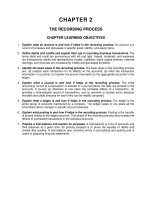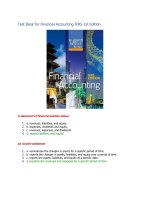Financial accounting IFRS 4 kieoso ch07 PPT
Bạn đang xem bản rút gọn của tài liệu. Xem và tải ngay bản đầy đủ của tài liệu tại đây (1.04 MB, 81 trang )
Financial Accounting
IFRS 4th Edition
Weygandt ● Kimmel ● Kieso
Chapter 7
Fraud, Internal Control, and Cash
Chapter Outline
Learning Objectives
LO 1
Define fraud and the principles of internal control.
LO 2
Apply internal control principles to cash.
LO 3
Identify the control features of a bank account.
LO 4
Explain the reporting of cash.
Copyright ©2019 John Wiley & Sons, Inc.
2
Learning Objective 1
Define Fraud and the Principles of Internal Control
Copyright ©2019 John Wiley & Sons, Inc.
3
Fraud and Internal Control (1 of 2)
Fraud
Dishonest act by an employee that results in
Opportunity
personal benefit to the employee at a cost to the
employer.
Financial Pressure
Rationalization
ILLUSTRATION 7.1 Factors that contribute to fraudulent activity
Copyright ©2019 John Wiley & Sons, Inc.
4
Fraud and Internal Control (2 of 2)
Internal Control
Purposes of internal control:
1.
Safeguard assets.
2.
Enhance accuracy and reliability of accounting records.
3.
Increase efficiency of operations.
4.
Ensure compliance with laws and regulations.
Copyright ©2019 John Wiley & Sons, Inc.
5
Internal Control (1 of 3)
Review Question
Internal control is used in a business to enhance the accuracy and reliability of its accounting
records and to:
a.
safeguard its assets.
b.
prevent fraud.
c.
produce correct financial statements.
d.
deter employee dishonesty.
Copyright ©2019 John Wiley & Sons, Inc.
6
Internal Control (2 of 3)
Review Question
Internal control is used in a business to enhance the accuracy and reliability of its accounting
records and to:
a.
safeguard its assets.
b.
prevent fraud.
c.
produce correct financial statements.
d.
deter employee dishonesty.
Copyright ©2019 John Wiley & Sons, Inc.
7
Internal Control (3 of 3)
Five Primary Components:
1.
Control environment.
2.
Risk assessment.
3.
Control activities.
4.
Information and communication.
5.
Monitoring.
Copyright ©2019 John Wiley & Sons, Inc.
8
Principles of Internal Control Activities (1 of 6)
Establishment of Responsibility
•
Control is most effective when only one person is responsible
for a given task
•
Establishing responsibility often requires limiting access only
to authorized personnel, and then identifying those
personnel
Copyright ©2019 John Wiley & Sons, Inc.
9
Principles of Internal Control Activities (2 of 6)
Segregation of Duties
•
Different individuals should be responsible for related activities
•
Responsibility for record-keeping for an asset should be separate
from physical custody of that asset
Copyright ©2019 John Wiley & Sons, Inc.
10
Principles of Internal Control Activities (3 of 6)
Documentation Procedures
•
Companies should use prenumbered
documents, and all documents should be
accounted for
•
Employees should promptly forward source
documents for accounting entries to the
accounting department
Copyright ©2019 John Wiley & Sons, Inc.
11
Principles of Internal Control Activities (4 of 6)
Physical Controls
Copyright ©2019 John Wiley & Sons, Inc.
12
Principles of Internal Control Activities (5 of 6)
Independent Internal Verification
•
Records periodically verified by an
employee who is independent
ã
Discrepancies reported to
management
Copyright â2019 John Wiley & Sons, Inc.
13
Principles of Internal Control Activities (6 of 6)
Human Resource Controls
•
Bond employees who handle cash
•
Rotate employees’ duties and require
vacations
•
Conduct background checks
Copyright ©2019 John Wiley & Sons, Inc.
14
Principles of Internal Control (1 of 2)
Review Question
The principles of internal control do not include:
a.
establishment of responsibility.
b.
documentation procedures.
c.
management responsibility.
d.
independent internal verification.
Copyright ©2019 John Wiley & Sons, Inc.
15
Principles of Internal Control (2 of 2)
Review Question
The principles of internal control do not include:
a.
establishment of responsibility.
b.
documentation procedures.
c.
management responsibility.
d.
independent internal verification.
Copyright ©2019 John Wiley & Sons, Inc.
16
Limitations of Internal Control
•
Costs should not exceed benefit
•
Human element
•
Size of the business
Helpful Hint
Controls may vary with the risk level of the activity. For example, management may consider cash to be high risk and
maintaining inventories in the stockroom as lower risk. Thus, management would have stricter controls for cash.
Copyright ©2019 John Wiley & Sons, Inc.
17
Do It! 1: Control Activities (1 of 3)
Identify which control activity is violated and explain how the situation creates an opportunity for a fraud.
1.
The person with primary responsibility for reconciling the bank account and making all bank deposits is also
the company’s accountant.
Solution
Violates the control activity of segregation of duties
Recordkeeping should be separate from physical custody
Employee could embezzle cash and make journal entries to hide the theft
Copyright ©2019 John Wiley & Son, Inc.
18
Do It! 1: Control Activities (2 of 3)
Identify which control activity is and explain how the situation creates an opportunity for a fraud.
2.
Wellstone Company’s treasurer received an award for distinguished service because he had not taken a
vacation in 30 years.
Solution
Violates the control activity of human resource controls
Key employees must take vacations
Treasurer, who manages the company’s cash, might embezzle cash and use his position to conceal the theft
Copyright ©2019 John Wiley & Son, Inc.
19
Do It! 1: Control Activities (3 of 3)
Identify which control activity is violated and explain how the situation creates an opportunity for a fraud.
3.
In order to save money spent on order slips and to reduce time spent keeping track of order slips, a local
bar/restaurant does not buy prenumbered order slips.
Solution
Violates the control activity of documentation procedures
If prenumbered documents are not used, then it is virtually impossible to account for the documents
An employee could write up a dinner sale, receive cash from customer, then throw away order slip and keep the
cash
Copyright ©2019 John Wiley & Son, Inc.
20
Learning Objective 2
Apply Internal Control Principles to Cash
Copyright ©2019 John Wiley & Sons, Inc.
21
Cash Controls (1 of 2)
Cash Receipts Controls
•
Establishment of Responsibility:
•
Only designated personnel are authorized to handle cash receipts
Segregation of Duties: Different individuals
Receive cash
Record cash receipts
Hold cash
Copyright ©2019 John Wiley & Son, Inc.
22
Cash Receipt Controls (1 of 5)
•
•
Documentation Procedures: Use
Remittance advice (mail receipts)
Cash register tapes or computer records
Deposit slips
Physical Controls
Store cash in safes and bank vaults
Limit access to storage areas
Use cash registers or point-of-sale terminals
Copyright ©2019 John Wiley & Son, Inc.
23
Cash Receipt Controls (2 of 5)
•
•
Independent Internal Verification
Supervisors count cash receipts daily
Assistant treasurer compares total receipts to bank deposits daily
Human Resource Controls
Bond personnel who handle cash
Require employees to take vacations
Conduct background checks
Copyright ©2019 John Wiley & Son, Inc.
24
Over-the-Counter Receipts
Cash Receipts Controls
Clerk
Supervisor
Enters sales,
Removes locked
counts cash
cash register tape
Sends cash and
Sends cash register tape
count to cashier
to accounting dept.
Cashier
Counts cash,
prepares deposit slips
Sends deposit slip copy to
accounting dept.
Delivers cash and
Accounting Department Agrees register
tape to deposit slip and
records journal entry
Bank
deposit slip to bank
Copyright ©2019 John Wiley & Son, Inc.
25









